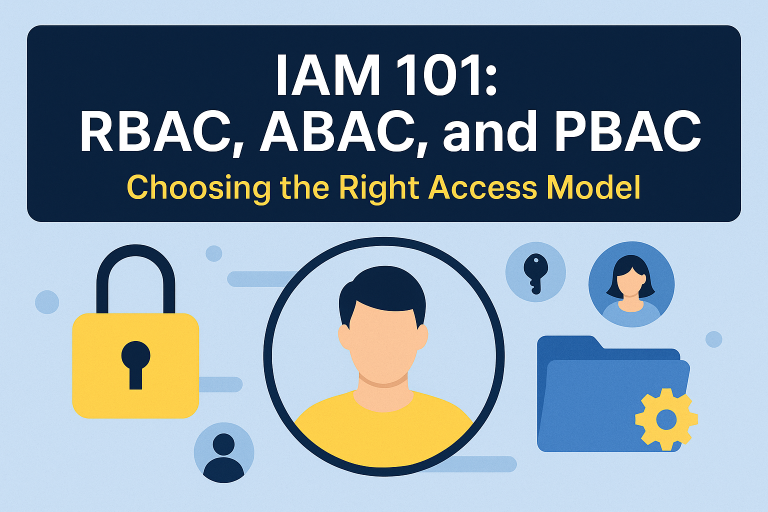
TL;DR
Access control models define who can access what within your systems—and more importantly, under what conditions. The most common models—RBAC (Role-Based Access Control), ABAC (Attribute-Based Access Control), and PBAC (Policy-Based Access Control)—offer different strengths depending on your organization’s complexity, compliance needs, and operational maturity. In this post, we’ll explore each model, compare real-world use cases, and help you decide which approach fits your identity strategy.
🔍 Background
In the IAM world, authorization is the engine that drives secure access—yet it’s also where things get messy. I’ve seen it firsthand during audits, mergers, app onboarding, and cloud migrations.
The first time I inherited a role matrix built on RBAC with 300+ overlapping roles? It was chaos. That was 2012. Since then, I’ve implemented cleaner, more scalable access control systems using ABAC and, in advanced cases, PBAC.
Choosing the right model isn’t just a technical decision—it’s a governance one. It determines how granular, flexible, and enforceable your access policies will be across on-prem, cloud, SaaS, and hybrid environments.
🧱 Access Control Models Explained
🔐 What is RBAC?
Role-Based Access Control assigns access based on job roles. Each role maps to a set of permissions, and users are assigned roles.
Example:
- A user in the “HR Manager” role automatically gets access to Workday, Payroll, and Benefits Admin.
✅ Pros:
- Easy to understand and manage
- Works well in stable orgs with clear job structures
- Widely supported in enterprise systems
❌ Cons:
- Explodes in complexity as exceptions grow
- Doesn’t scale well across dynamic environments
- Often leads to “role creep” (users get too many roles)
🧠 What is ABAC?
Attribute-Based Access Control goes beyond roles by evaluating attributes—user department, location, device trust level, time of day, etc.
Example:
- “Allow access to the finance dashboard if user.department = ‘Finance’ AND device.compliant = true AND location = ‘US’.”
✅ Pros:
- Highly granular and dynamic
- Ideal for modern, hybrid environments
- Supports context-aware security
❌ Cons:
- Can be hard to audit or visualize
- Policy logic can become complex
- Needs clean, consistent attribute data
📜 What is PBAC?
Policy-Based Access Control (often seen as an evolution of ABAC) centers around central, codified policies written in natural or declarative language.
Example:
- “Managers can approve expense reports for direct reports under $5,000.”
- “Deny access to sensitive data unless classification = ‘Internal’ and user has completed training.”
✅ Pros:
- Expressive, business-aligned policies
- Useful in governance-heavy industries (finance, healthcare)
- Enables Just-in-Time and risk-based access models
❌ Cons:
- Requires robust policy engine (like Axiomatics, PlainID)
- Strong coordination between IAM and business units
- Learning curve for authoring policies
⚖️ RBAC vs ABAC vs PBAC: Side-by-Side Comparison
| Feature | RBAC | ABAC | PBAC |
|---|---|---|---|
| Primary Driver | Role | Attributes (user, resource, env) | High-level business policy |
| Granularity | Medium | High | Very High |
| Scalability | Low-Medium | High | High |
| Ease of Setup | Easy | Moderate | Hard |
| Auditability | Easy | Moderate | Depends on implementation |
| Best Fit For | Small/medium orgs with static roles | Enterprises with dynamic access needs | Regulated industries needing fine-grained access logic |
🏢 Real-World Use Cases
🧾 Healthcare Organization – RBAC First, Then ABAC
A healthcare system I worked with started with classic RBAC (Doctors, Nurses, Admins) but added ABAC when telehealth rolled out. Now, patient records are only viewable if:
- The user is assigned to the patient’s care team
- Access is from a compliant device
- The shift is currently active
🏛️ Government Agency – PBAC for Zero Trust
A federal agency uses PBAC to implement Zero Trust. Access is defined by central policies like:
“Only users who have completed clearance check and are within U.S. jurisdiction may access classified documents.”
Policies are enforced through integration with SIEM and UEBA tools that feed into dynamic risk scoring.
📊 Cited Study
According to Gartner’s “Market Guide for Attribute-Based Access Control” (2022), by 2026, 60% of enterprises will phase out pure role-based models in favor of attribute and policy-based methods to handle complex, dynamic workforces and multi-cloud access needs.
🔧 Implementation Tips for IT Teams
If you’re evaluating your access control strategy, here’s how I recommend approaching it:
1. Start Simple
Use RBAC to handle common, static job functions. Get your roles cleaned up and mapped properly.
2. Layer in ABAC Where Needed
Don’t rip and replace. Add ABAC where roles fall short—like context-aware access, contractor logic, or hybrid user states.
3. Build Toward Policy Governance
If you’re in a regulated industry or preparing for Zero Trust, start introducing PBAC policies aligned to business outcomes (e.g., data classification, training completion, risk score).
4. Leverage Your IdP or IGA Platform
Modern IAM platforms like Okta, Azure AD, SailPoint, or Saviynt often support hybrid RBAC/ABAC logic. Use these tools to enforce least privilege dynamically.
5. Don’t Skip Auditing and Review
No matter the model, ensure access is reviewed quarterly and attested by business owners.
🧭 Final Thoughts
There’s no one-size-fits-all access model. But here’s how I like to think of it:
- RBAC is great for static environments with clear roles.
- ABAC is essential for dynamic, hybrid, and cloud-based work.
- PBAC is your go-to when business rules drive access—or when regulators require explainability.
The best programs use a hybrid approach—starting with RBAC for structure, layering ABAC for flexibility, and adopting PBAC for risk-based governance.
As identity professionals, our goal isn’t just granting access—it’s granting the right access, at the right time, for the right reason.
🚀 Up Next in the Series:
👉 IAM 101: Lifecycle Management – Joiners, Movers, and Leavers Done Right